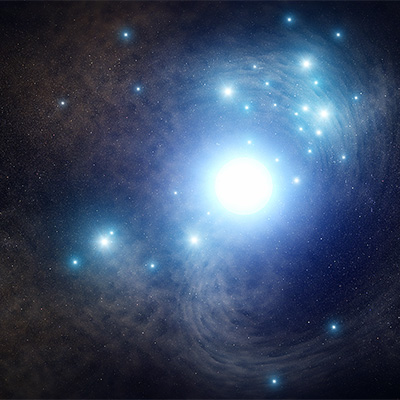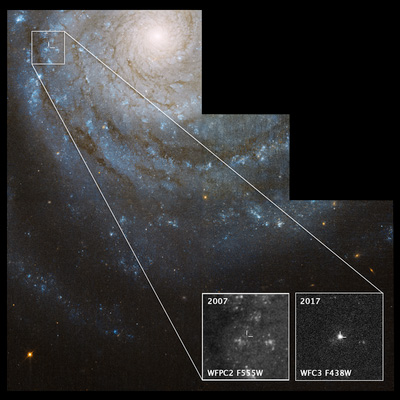Astronomers may have finally uncovered the long-sought progenitor to a unique type of exploding star by sifting through NASA Hubble Space Telescope archival data. The supernova, called a type Ic, is thought to detonate after its massive progenitor star has shed or been stripped of its outer layers of hydrogen and helium.
These stars could be among the most massive known, at least 30 times heftier than our Sun. Even after shedding some of their material late in life, they are expected to be big and bright. So it was a mystery why astronomers had not been able to nab one of these stars in pre-explosion images.
Finally, in 2017, astronomers got lucky. A nearby star ended its life as a type Ic supernova. Two teams of astronomers poured through the archive of Hubble images to uncover the putative progenitor in pre-explosion photos taken in 2006. The supernova, catalogued as SN 2017ein, appeared near the center of the nearby galaxy spiral NGC 3938, located roughly 65 million light-years away.
This potential discovery could yield insight into stellar evolution, including how the masses of stars are distributed when they are born in batches.
“We were fortunate that the supernova was nearby and very bright, about five to 10 times brighter than other type Ic supernovas, which may have made the progenitor easier to find,” said Charles Kilpatrick, a postdoctoral researcher at UC Santa Cruz and leader of one of the teams.
“Finding a bona fide progenitor of a supernova Ic is a big prize of progenitor searching,” said Schuyler Van Dyk of the California Institute of Technology in Pasadena, lead researcher of the other team. “We now have for the first time a clearly-detected candidate object.”
The Van Dyk team’s paper was published in June in the Astrophysical Journal. The paper by Kilpatrick's team, which appeared in the July issue of the Monthly Notices of the Royal Astronomical Society, is consistent with the earlier team’s conclusions.
“Astronomers have observed many type Ic supernovas, but they are all too far away for Hubble to resolve,” Kilpatrick said. “You need one of these massive, bright stars in a nearby galaxy to go off. It looks like most type Ic supernova progenitors are less massive and therefore less bright, and that’s the reason we haven’t been able to find them.”
An analysis of the object’s colors shows that the candidate is extremely luminous and very hot and blue. Based on that assessment, both teams suggest two possibilities for the source’s identity. The progenitor could be a single hefty star between 45 and 55 solar masses or a massive binary star system in which one of the stars weighs between 60 and 80 solar masses and the other roughly 48 solar masses. In this scenario, the stars are orbiting closely and interact with each other. The more massive star is stripped of its hydrogen and helium layers, eventually exploding as a supernova.
The possibility of a massive double-star system is a surprise. “This is not what we would expect from current models, which call for lower-mass interacting binary progenitor systems,” Van Dyk said.
But the nature of the progenitors of type Ic supernovas has been a puzzle. Astronomers have known that the supernovas were deficient in hydrogen and helium, and initially proposed that some hefty stars shed this material in a strong wind (a stream of charged particles) before they exploded. When they didn’t find the progenitor stars, which should have been extremely massive and bright, they suggested a second method to produce the exploding stars. An interaction between a pair of lower-mass binary stars would mean the one star stripped hydrogen and helium layers from the companion star. By gobbling up material from its companion, the more massive star would evolve faster and end its life in a supernova blast.
“Disentangling these two scenarios for producing type Ic supernovas impacts our understanding of stellar evolution and star formation, including how the masses of stars are distributed when they are born to how many stars form in interacting binary systems,” explained Ori Fox of the Space Telescope Science Institute (STScI) in Baltimore, Maryland, a member of Van Dyk’s team. “And that is one of the questions that not just astronomers studying supernovas want to know but all astronomers are after.”
Type Ic supernovas are just one class of exploding star. They account for 21 percent of massive stars that explode from the collapse of their cores.
The teams caution that they won’t be able to confirm the source’s identity until the supernova fades in about two years. The astronomers hope to use either Hubble or the upcoming NASA James Webb Space Telescope to see whether the candidate progenitor star has disappeared or has significantly dimmed. They also will be able to separate the progenitor star’s light from that of stars in its environment to calculate a more accurate measurement of the object’s brightness and mass.
SN 2017ein was discovered in May 2017 by Tenagra Observatories in Arizona. But it took the sharp resolution of Hubble to pinpoint the exact location of the possible source. Van Dyk’s team imaged the young supernova in June 2017 with Hubble’s Wide Field Camera 3. The astronomers used the Hubble image to pinpoint the candidate progenitor star nestled in the host galaxy’s spiral arm in archival Hubble photos taken in October 2006 by the Wide Field Planetary Camera 2.
Kilpatrick’s group observed the supernova also in June 2017 in infrared images with one of the 10-meter telescopes at the W.M. Keck Observatory in Hawaii. The team then turned to the Hubble archive to uncover a pre-explosion photo showing the possible source taken in December 2007 with the Wide Field Planetary Camera 2.
In addition to Kilpatrick, the coauthors of the paper include Ryan Foley, Tyler Takaro, Camille Leibler, Yen-Chen Pan, Claire Max, and Sophia Medallon at UC Santa Cruz; Randall Campbell, Hilton Lewis, and James Lyke at the W. M. Keck Observatory; and Armin Rest at the Space Telescope Science Institute.




